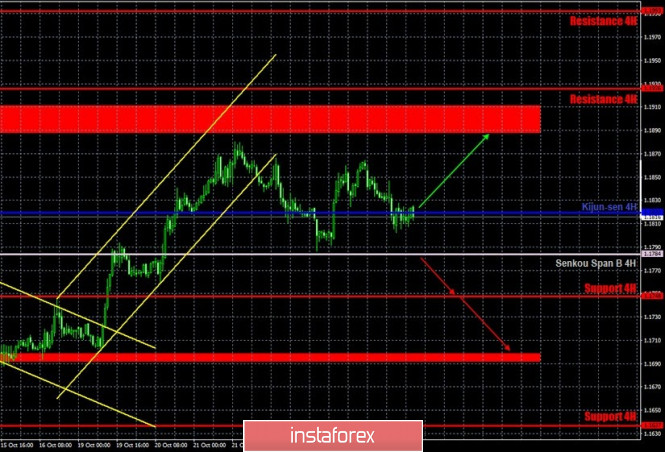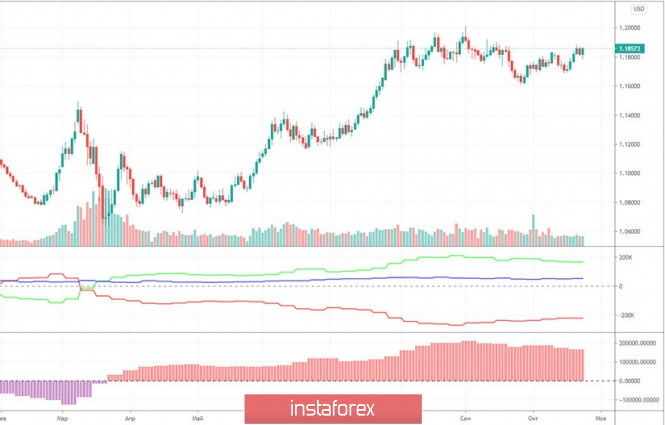EUR/USD 1H

The EUR/USD pair began to correct again on the hourly timeframe on Monday, October 26, but now everything looks as if a new stage of horizontal movement is starting. First, it is now impossible to build a more or less convincing trendline or trend channel. It is impossible to thoroughly determine the current trend (it is also not visible to the naked eye). Secondly, we continue to remind traders that the pair remains within the 1.17-1.19 horizontal channel (or its alternative 1.1640-1.1920), thus, in the long term, the flat remains. Thirdly, the fundamental background now is such that it is impossible to draw a conclusion about the advisability of buying or selling. Even the Kijun-sen and Senkou Span B lines, which are strong lines, now do not make much sense, since it is also impossible to trade against them.
EUR/USD 15M

The lower linear regression channel turned to the downside on the 15-minute timeframe, indicating a new round of corrective movement on the hourly chart. However, sellers need to break the 1.1784 level to have a chance of falling further.
COT report

The EUR/USD pair fell by around 40 points during the last reporting week (October 13-19). But in general, no significant price changes have been observed for the pair in recent months. Therefore, data from any Commitment of Traders (COT) report can only be used for long-term forecasting. The new COT report showed even fewer changes in the mood of professional traders than the previous one. Non-commercial traders, who, we recall, are the most important group of traders in the foreign exchange market, opened 1,081 Buy-contracts (longs) and 673 Sell-contracts (shorts). Take note that the "non-commercial" group decreased its net position in the last two weeks, which may indicate the end of the upward trend. However, the data provided by the latest COT report does not tell us anything at all. There are no changes, since non-commercial traders have opened almost 300,000 euro contracts. Thus, opening or closing of 1,000-2.000 contracts does not indicate anything. The lines of net positions of the "non-commercial" and "commercial" groups (upper indicator, green and red lines) continue to barely narrow, while the pair itself continues to trade in a horizontal channel. Therefore, we stick to our opinion - the upward trend is completed or is about to be completed, and the high reached near the 1.2000 level may remain the peak of this trend.
No macroeconomic reports from the European Union or America on Monday. Therefore, it is easy to explain why trading was very calm during the day, and it is also logical. Several minor reports from Germany had no effect on the mood of traders. In general, the fundamental background has not changed at all lately, and so the fact that the euro/dollar pair has been standing in one place for three months is also quite logical. Market participants continue to wait for the US elections and their results. Coronavirus in the eurozone causes great concern, but one should not forget that the epidemic is also present in the United States, no weaker than in Europe. The EU is set to publish a report on orders for durable goods on Tuesday. In normal times, this is a fairly important report, since the category of durable goods is distinguished by its high cost. However, the latest report showed minimal changes in indicators, and forecasts for the upcoming data are equally neutral. Therefore, we believe that this report will not have any impact on the pair, unless the numbers turn out to be over-optimistic or overly disappointing.
We have two trading ideas for October 27:
1) The pair still maintains an upward trend. Thus, traders are advised to continue to trade upward while aiming for the resistance area of 1.1887-1.1912 and the 1.1926 level as long as the price is above the strongest line of Senkou Span B (1.1784). Take Profit in this case can be up to 100 points. However, the 1.1887-1.1912 and 1.1900-1.1920 areas are extremely strong and the bulls are unlikely to be able to overcome them.
2) Bears remain in the shadows. Thus, sellers need to wait for the price to break through the Senkou Span B line (1.1784) in order to have reasons to open sell positions while aiming for the 1.1748 level and the support area of 1.1692-1.1699. The potential Take Profit in this case is from 30 to 70 points.
Explanations for illustrations:
Support and Resistance Levels are the levels that serve as targets when buying or selling the pair. You can place Take Profit near these levels.
Kijun-sen and Senkou Span B lines are lines of the Ichimoku indicator transferred to the hourly timeframe from the 4-hour one.
Support and resistance areas are areas from which the price has repeatedly rebounded off.
Yellow lines are trend lines, trend channels and any other technical patterns.
Indicator 1 on the COT charts is the size of the net position of each category of traders.
Indicator 2 on the COT charts is the size of the net position for the "non-commercial" group.
The material has been provided by InstaForex Company - www.instaforex.com